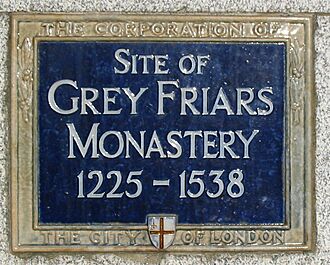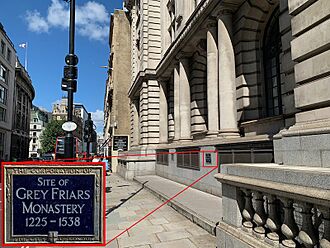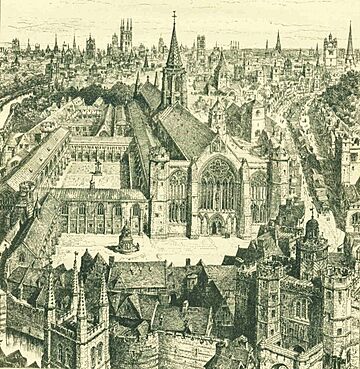Greyfriars, London facts for kids
The Greyfriars was a special religious house in London. It was home to a group of friars called the Franciscans. They lived there from 1225 to 1538. The friary was located in the north-west part of the City of London, near a gate called Newgate.
It was the second Franciscan house ever built in England. The Greyfriars had a very large church, one of the biggest in London. It also had a studium, which was like a regional university. There was also a huge library filled with important books.
In the 1300s, the Greyfriars was a major learning center. It was almost as important as Oxford University. Famous thinkers like William of Ockham lived there. The friary was very successful for many years.
However, in 1538, Henry VIII closed it down. This was part of a big event called the Dissolution of the Monasteries. Later, a famous school called Christ's Hospital was started in the old buildings. The church was rebuilt by Sir Christopher Wren after a big fire. Today, a modern building stands on the site.
The friars were called "Greyfriars" because they wore simple grey robes.
Contents
The Greyfriars' Story
How the Friary Started
The Franciscan Order first came to England in 1224. They settled in London in the summer of 1225. A rich businessman named John Iwyn bought land for them. This land was in an area called St Nicholas in the Shambles. It was just inside the city wall, next to open fields.
Three years later, another person gave them more property. Over the next 130 years, many Londoners donated land. The last gift was from Queen Isabella of France in 1353 or 1354. In 1229, King Henry III gave the friars wood to build their home.
By 1243, about eighty friars lived there. They expanded their site to the north and west by 1258. The first church was built with money from William Joynier. He was the mayor of London in 1239. He paid for the chapel and gave money for other buildings.
Building the Great Church
More work on the church began in the late 1200s. Henry le Walleis, another London mayor, helped build the main part of the church. He also gave wood for the altars. In 1301–1302, Queen Margaret bought more land for the Greyfriars. She was the second wife of King Edward I.
The church's choir was built on this new land. Queen Margaret paid a lot of money for the church's construction. She spent 2,000 marks before she died in 1318. The church was still not finished then. Queen Isabella of France, wife of Edward II, completed the work. She spent about £700. The total cost of the new church was around £2700, which was a huge amount of money back then.
The church had six chapels and eight other altars. It also had many statues of saints. It became a popular burial place for important people. Queen Margaret was buried there. So was Isabella, the wife of Edward II. The heart of Eleanor of Provence, Henry III's wife, was also buried there.
The church was built in the Gothic style. It was finished in 1348. It was the second-largest church in medieval London. It was 300 feet (91 meters) long and 89 feet (27 meters) wide.
The Friary Closes Down
The monastery was closed in 1538. This happened because of Thomas Cromwell, an agent of King Henry VIII. On November 12, the friars signed a paper agreeing to give up their home. They had to say that Christian life was not about "wearing a grey coat" or "disguising ourselves after strange fashions."
After the friary closed, some buildings were used as private homes. The church was shut down. It was used to store treasure taken from France. In 1547, the king gave the church and other buildings to the City of London. The church was renamed Christ Church Greyfriars. It became the church for a new parish. It reopened on January 30, 1547. Sadly, it was destroyed by the Great Fire of London in 1666.
What Happened Next
Christ's Hospital, also known as the Blue Coat School, was founded in 1553. It was a school for orphans. It used some of the old friary buildings. Edward VI started this school. The school moved to Horsham in West Sussex in 1902.
Buildings and What Remains Today
The original Greyfriars buildings are no longer there. The church was rebuilt after the Great Fire of London. Today, a modern building stands on the site. It was designed by a company called Arup Group Limited. This building is currently used by Merrill Lynch.
You can still find blue plaques in London that mark where the Greyfriars once stood. These plaques help us remember this important part of London's history.





